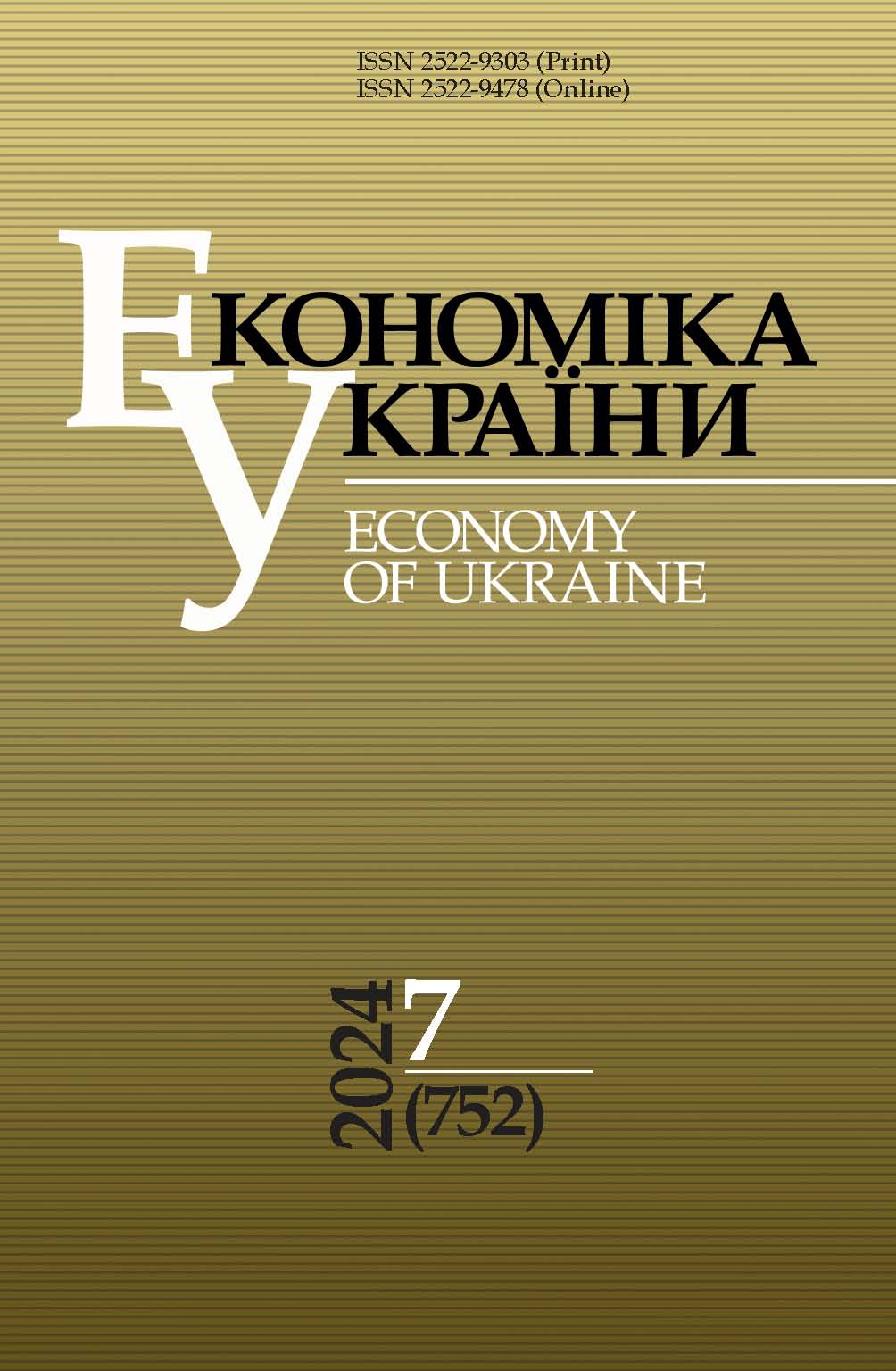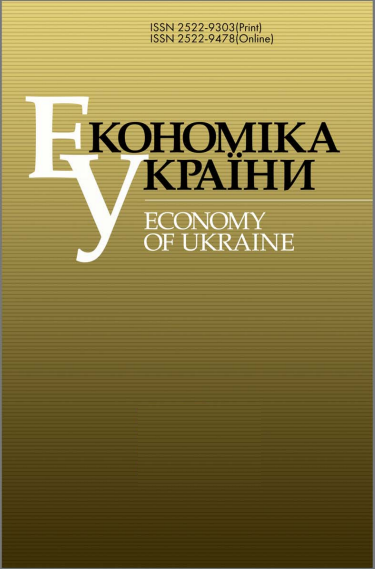NATURAL RESOURCE ASSETS AS FACTOR FOR ENSURING THE QUALITY OF LIFE OF TERRITORIAL ENTITIES’ POPULATION
DOI:
https://doi.org/10.15407/economyukr.2024.07.049Keywords:
natural resource asset; spatial development; quality of life; territorial entity; resilienceAbstract
The concept of natural resource asset is defined as a component of natural wealth institutionalized in the economic process and embodied in tangible and intangible forms, which has exchange and consumption value, and as a result of it being involved in economic activity by economic entities added value is created and flows of benefits are obtained from use of natural resources as goods, means and factors of production.
It has been established that any natural resource asset simultaneously has two sets of features, the first of which is characteristic of it as capital of natural origin, and the second as an asset. On this basis, a generalized classification of natural resource assets is proposed. They are identified as capital that exhibits a dualistic value of use / non-use, is involved in reconstructive development, on the one hand, as a component of the natural environment and a factor in the formation of human life activity environment, and on the other hand – as a resource and a factor in the resilient development of territorial entities. Essential features of economic systems’ resilience have been revealed, based on them the prediction is made about reaching homeostatic equilibrium after disruption of their normal functioning and the beginning of the growth trajectory, which will be accompanied by the expansion and improvement of the quality of competences, the effectiveness of the territorial economy with the involvement of natural resource assets.
Natural resource assets are characterized as spatial development tools, which simultaneously play three roles in the social production system – raw material and energy resources, means and factors of production development and commodity-market relations, as well as quality of life factors. The potential positive effects of natural resource assets integration into the economic circulation on the population’s quality of life have been identified, including enhancing the environmental safety of the economy, formation of attractive conditions for economic activity and population's living, which will contribute to the normalization of the demographic situation in the country.
References
Boyce, J. (2001). From Natural Resources to Natural Assets. New Solutions. A Journal of Environmental and Occupational Health Policy. Vol. 11. Iss. 3. P. 267-288. https://doi.org/10.2190/5QPY-TPE0-JP5W-5
Boyce, J., Pastor, M. (2001). Building Natural Assets: New Strategies for Poverty Reduction and Environmental Protection. Political Economy Research Institute, University of Massachusetts. 26 p. URL: https://www.researchgate.net/publication/23693627_Building_Natural_Assets_New_Strategies_for_Poverty_Reduction_and_Environmental_Protection
Khvesyk, M. (Ed.) (2017). Formation of system of natural resource management mechanisms in the context of European integration processes. Kyiv. 595 p. URL: https://www.nas.gov.ua/UA/Book/Pages/default.aspx?BookID=0000010435 [in Ukrainian].
Khvesyk, M. (Ed.) (2020). Formation of spatial management system of natural resource assets. Kyiv. 464 p. URL: https://library.nusta.edu.ua/depository/Електроннi%20книжки/Монографії/Монографія%202020_заг_ред_Хвесик_ДУІЕПСРНАНУ_ФОРМУВАННЯ%20ПРОСТОРОВОЇ%20СИСТЕМИ%20УПРАВЛІННЯ.pdf [in Ukrainian].
Khvesyk, M. (Ed.) (2021). Ukraine's natural resource potential: ensuring the well-being and environmental safety of the population. Kyiv. 148 p. URL: https://files.nas.gov.ua/PublicMessages/Documents/0/2021/12/220120141057192-1767.pdf [in Ukrainian].
Khvesyk, M., Bystriakov, I., Klynovyi, D. (2018). Financial and economic mechanism of Ukraine’s reconstructive development on the bases of decentralized management of natural resources. Economy of Ukraine. 61. 3 (676). 3-20. https://doi.org/10.15407/economyukr.2018.03.003 [in Ukrainian].
Veklych, O. (2020). Essential characteristic of ecosystem assets of territorial communities. Efficient Economy. No. 5. https://doi.org/10.32702/2307-2105-2020.5.17 [in Ukrainian].
Veklych, O. (2021). Frame-concept of valuation of ecosystem assets of territorial communities. Environmental Economics and Sustainable Development. No. 9 (28). P. 43-49. URL: http://dspace.nbuv.gov.ua/handle/123456789/183398 [in Ukrainian].
Kolmakova, V. (2020). Key Signs of Ecosystem Assets Valuation. Business, Economics, Sustainability, Leadership and Innovations (BESLI). Iss. 5. P. 23-28. URL: https://www.besli.org/index.php/besli/article/download/41/40 [in Ukrainian].
Shevchenko, H. (2020). Balancing the Management Factors of Natural-Resource Assets of the Recreation and Tourism Sphere of the National Economy. Business Inform. No. 12. P. 82-90. URL: https://www.business-inform.net/article/?year=2020&abstract=2020_12_0_82_90 [in Ukrainian].
Ostapchuk, S., Tsaruk, N. (2019). Accounting for Water, Land and Biological Assets in the Context of Sustainable Development Management: The Choice of a Main Meter. Accounting & Finance. No. 2. P. 36-47. URL: http://nbuv.gov.ua/UJRN/Oif_apk_2019_2_7 [in Ukrainian].
Shpyliova, Yu., Il’yina, M. (2018). Advancing active-oriented approach to the development of territorial communities. Business Navigator. Vol. 1 (2). P. 63-67. URL: http://nbuv.gov.ua/UJRN/bnav_2018_1%282%29__13 [in Ukrainian].
Pyrozhkov, S., Khvesyk, M. (Eds.) (2015). Economic assessment of the natural wealth of Ukraine. Kyiv. 396 p. URL: https://www.nas.gov.ua/siaz/Ways_of_development_of_Ukrainian_science/article/16048.030.pdf [in Ukrainian].
Burkynskyi, B., Khumarova, N., Shevchenko, H. (2020). Some aspects of state governance of natural assets in Ukraine. Economic innovations. Vol. 22. No. 1 (74). P. 8-19. https://doi.org/10.31520/ei.2020.22.1(74).8-19 [in Ukrainian].
Klynovyi, D., Petrovska, I. (2024). Natural resource assets as spatial development tools and quality of life factors. In: Entrepreneurship and business administration in wartime: contemporary challenges, trends and transformations. Proc. int. sci.-pract. Internet conf. (Kharkiv, Feb 1-28, 2024). P.T. Bubenko, O.Yu. Palant, O.O. Rudachenko (editorial board). Kharkiv. 372 p. P. 173-175. URL: https://knameedu-my.sharepoint.com/:b:/g/personal/vitalina_konenko_kname_edu_ua/EVDD1m50PIBDuyNj_-JIfyUB9CQRB99LYJqVijHI_UJycg?e=ZfQenT [in Ukrainian].
Klynovyi, D., Petrovska, I. (2023). Natural assets in the territorial economy. In: Management paradigms of sustainable development and inclusive economic growth. Proc. int. sci.-pract. conference. I.I. Rekunenko, V.V. Sulym (Eds.). Sumy. 404 p. P. 36-38. URL: https://management.biem.sumdu.edu.ua/docs/t_2023.pdf [in Ukrainian].
Hafele, J., Barth, J., Le Lannou, L.-A., Bertram, L., Tripathi, R., Kaufmann, R., Engel, M. (2022). A framework for economic resilience: guiding economic policy through a social-ecological transition. ZOE Institute for Future-fit Economies. Transformation Policy Brief. No. 9-12. URL: https://zoe-institut.de/wp-content/uploads/2023/10/ZOE_Economic_Resilience_Framework.pdf
Martin, R., Sunley, P. (2015). On the Notion of Regional Economic Resilience: Conceptualization and Explanation. 51 p. URL: https://www.geog.cam.ac.uk/files/research/projects/cger/Onthenotion.pdf
Khvesyk, M., Bystriakov, I., Klynovyi, D. (2020). Public-private partnership in sustainable spatial development. Economy of Ukraine. 63. 1 (698). 3-23. https://doi.org/10.15407/economyukr.2020.01.003 [in Ukrainian].
Khvesyk, M. (Ed.) (2019). Public-private forms of ensuring sustainable spatial development of Ukraine. Kyiv. 723 p. URL: https://www.nas.gov.ua/UA/Book/Pages/default.aspx?BookID=0000015965 [in Ukrainian].
Downloads
Published
How to Cite
Issue
Section
License
Copyright (c) 2024 Publisher PH "Academperiodyka" of the NAS of Ukraine

This work is licensed under a Creative Commons Attribution-NonCommercial-NoDerivatives 4.0 International License.



